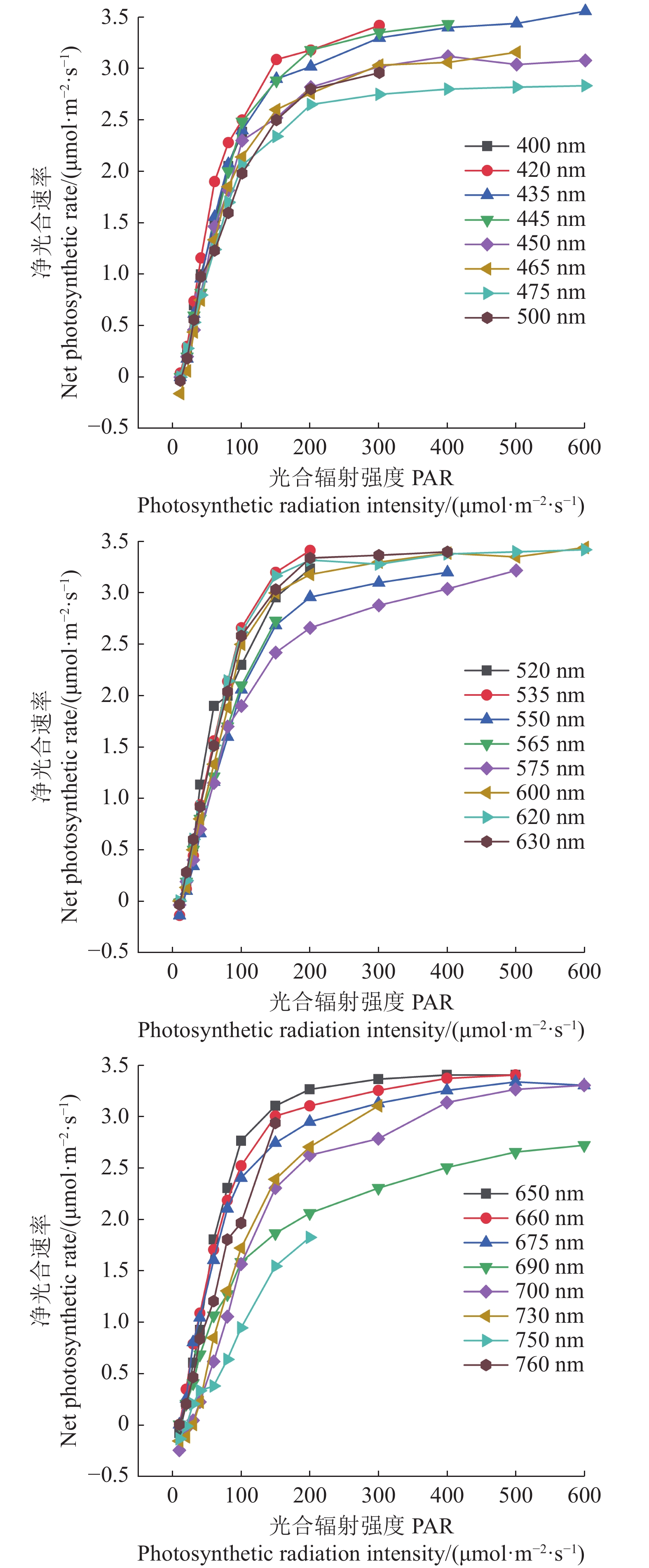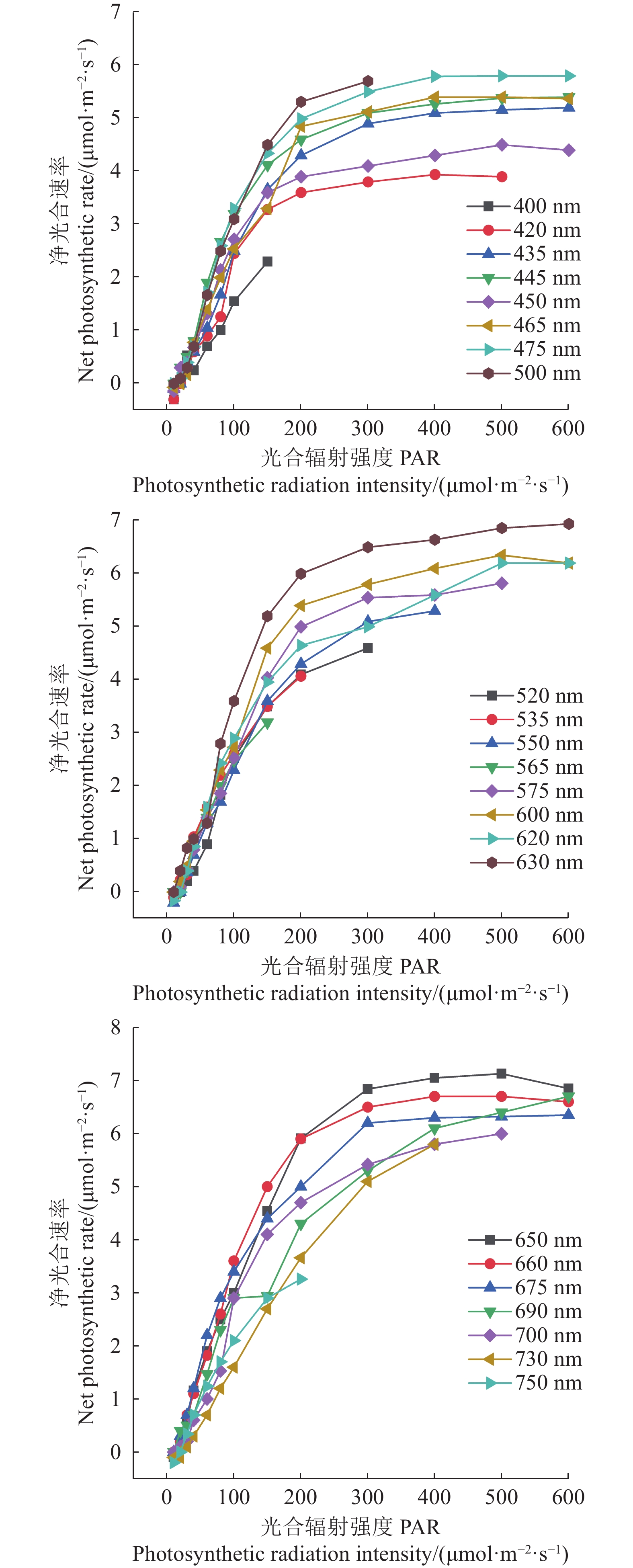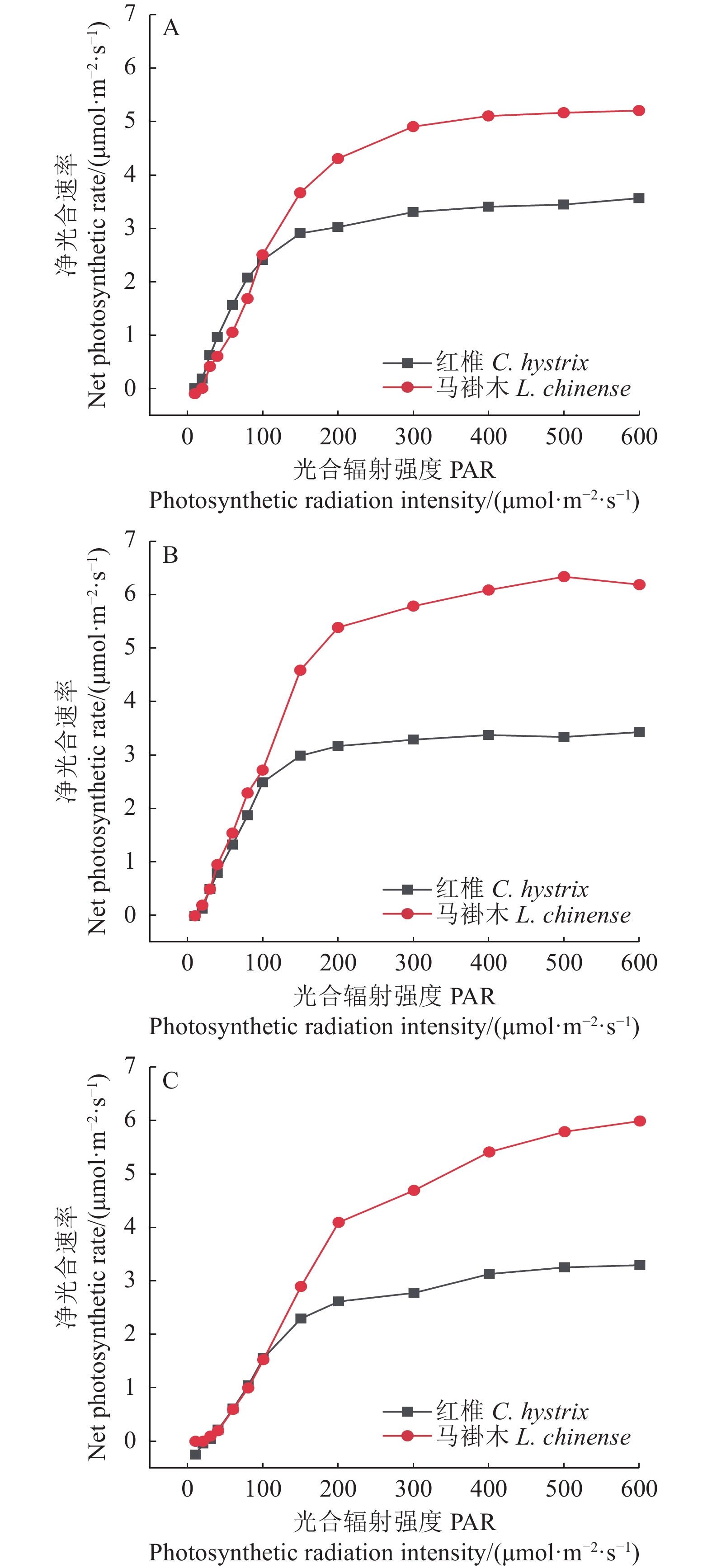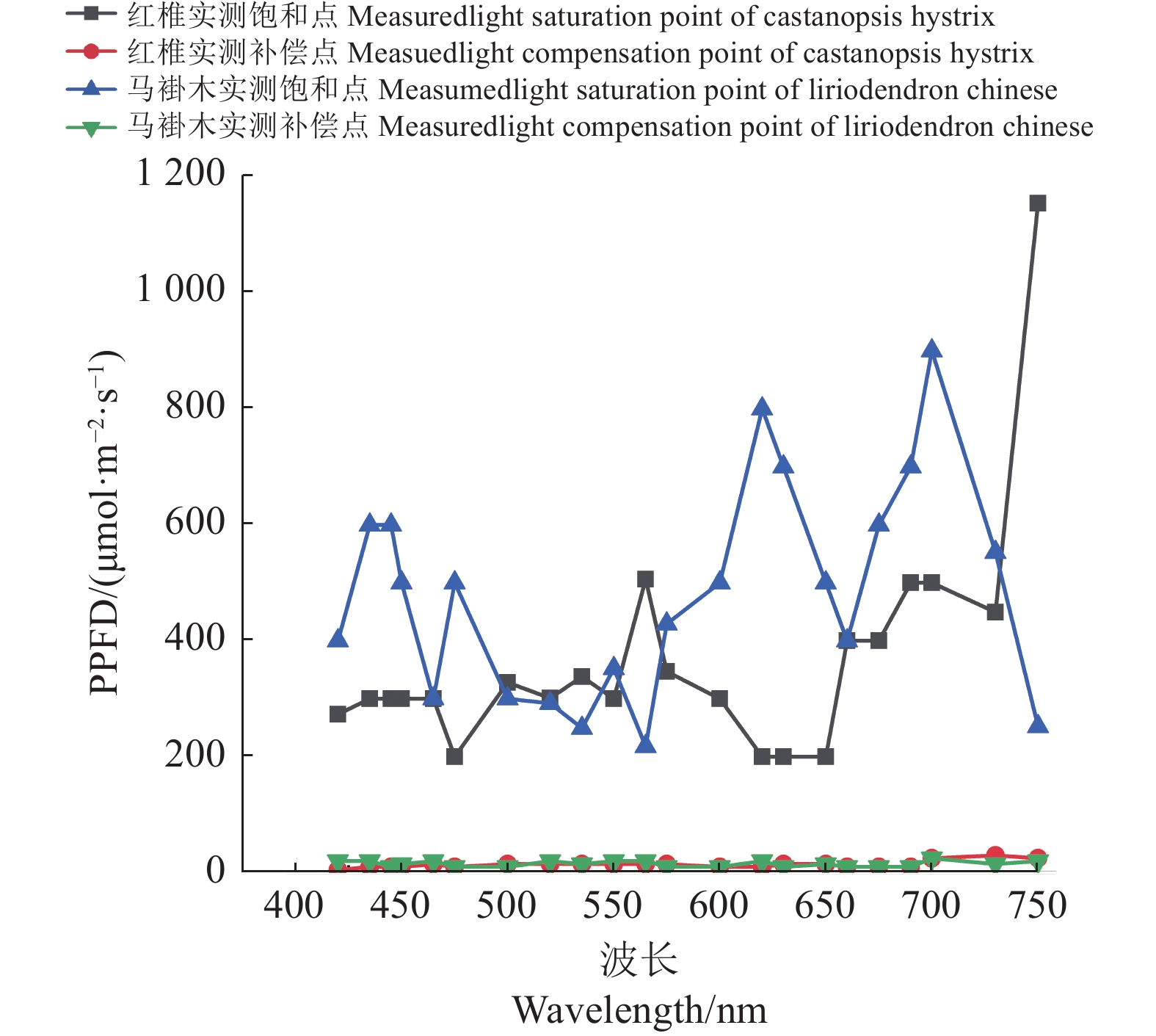Light Response Curves and Photosynthesis Models on Plants Exposed to Monochromatic Lights
-
摘要:目的 研究不同植物幼苗在多种单色光条件下的光合响应曲线及其数学模型,为植物工厂作物栽培架等现代农业种植设施的研发提供理论依据。方法 应用植物特征光谱试验方法及其测试系统,获取10种植物幼苗的22种单色光的光合响应曲线;选择红椎与马褂木两个具有代表性的植物,得出对应单色光光合响应曲线的数学模型;根据渐近线型单色光植物光合响应曲线的特点提出准饱和点光强的概念及计算方法,再依据所测定的植物幼苗22种单色光的饱和点光强,比较理论计算值与实际测定值的偏差程度,并以此为基础绘制植物光合作用饱和点曲线。结果 植物幼苗的光合响应曲线可分为两类,以红椎为代表的一类植物光合响应曲线呈渐近线型,这类曲线没有极值;以马褂木为代表的一类植物光合响应曲线则有拐点,这类曲线有极值。模型计算得到的准饱和点光强与实际测定的饱和点光强具有较高的拟合度,经过对数据的综合处理,获得对应的饱和点曲线和补偿点曲线。结论 采用植物特征光谱试验方法及其测试系统可以得到植物在单色光条件下的光合响应曲线,揭示了不同植物光合作用的规律及特点。由此提出的植物光合响应数学模型与实测值具有较高拟合度,可作为研究分析植物光合作用现象的重要参考。Abstract:Objective Mathematical models of the photosynthetic responses of plants exposed to monochromatic lights were constructed for the development of indoor agricultural cultivation.Method An experimentation was designed to generate varied wavelengths of monochromatic lights and test, measure, and construct a mathematical model for the photosynthetic responses of plants exposed to the light source. On seedlings of 10 different plant species grown under 22 varied monochromatic lights, the photosynthetic rates of the plants were measured to obtain light response curves (LRCs). Using Castanopsis hystrix and Liriodendron chinense (Hemsl.) Sarg as two representative plants, mathematical models were constructed. From the asymptotic linear curve, the light intensity at quasi-saturation point was calculated. Then, the calculated theoretical and measured empirical data were compared to test the validity of the prediction model.Result Of all the LRCs, there were two types—one of C. hystrix, which was asymptotic linear showing no plateau, and another of L. chinense, which had an inflection point. A high degree of fitting was found between the light intensity at quasi-saturation point calculated from the model and that measured empirically. After a data treatment, curves with light saturation and compensation points were obtained.Conclusion The specially designed monochromatic lights generating method and plant photosynthesis measuring system enabled a successful construction of the LRCs. The patterns and characteristics of the photosynthesis of different plants in response to the monochromatic lights varied. The high fitting on the photosynthetic response data between the values calculated from the mathematical model and those measured from the experiment suggested an applicability of the current methodology for studies on plant photosynthesis. Since the developed method and test system were not species-specific, they could be used universally for research on other plants. And using the mathematical model, optimal light wavelength and intensity at saturation point could be estimated for designing artificially controlled agriculture facilities such as “plant factories” for indoor mass crop cultivation.
-
0. 引言
【研究意义】中国沙棘(Hippophae rhamnoides subsp. sinensis Rousi)抗逆能力强,耐寒、耐旱、耐盐碱、耐瘠薄,具有抗风沙、保持水土、固氮解磷解钾等特性,是青藏高原首选的造林树种[1−2]。在青海复杂的自然条件下中国沙棘分布范围广,生态适应性强,因原始生存环境复杂,沙棘类群多样且种类丰富,因而相较于人工种植的沙棘其功能基因更加多样,遗传物质更加丰富,更有利于研究根际促生菌丰富度和多样性[3]。通过对野生沙棘根际土壤假单胞属菌株的筛选及其解磷解钾固氮降解纤维素等促生功能研究,可以提高土壤养分分解速率,增加土壤的养分含量,使农作物获得更好的生长环境[4]。【前人研究进展】根际促生菌可以通过黏附到矿物表面并释放酸性物质,将难溶性钾、磷和硅等营养元素释放出来进而供植物吸收利用[5−8]。目前,从植物根际土中分离出的菌株主要有假单胞菌、芽孢杆菌、不动杆菌,其中假单胞菌是青藏高原地区根际促生菌的优势菌株,具有溶磷、解钾、固氮和促进植物生长等作用[9]。马福林等[10]从西藏沙棘中分离出了具有解磷解钾功能的假单胞菌菌株,西藏沙棘接种该菌株后生长得到明显改善。Hameeda等[11]混合接种5种不同菌属的菌株于玉米后发现,假单胞菌可显著提高种子发芽率,并能促进玉米生长,减少氮肥使用。杨晓帆等[12]对桃树根际土壤中的假单胞菌进行分离筛选,发现桃树接种假单胞菌对其叶片、须根数、株高、鲜质量均有明显的促生效应。近些年来的研究表明,植物根际中分离的假单胞菌菌株在促进种子萌发、幼苗生长、提高农作物产量、品质和改善土壤特性等方面起着重要的作用[13]。【本研究切入点】目前,根际促生菌中的分离鉴定工作主要集中在玉米、马铃薯等经济作物方面[14−16],对沙棘,尤其是青海野生中国沙棘根际促生菌中的分离及研究其多功能能力的相关研究鲜有报道。【拟解决的关键问题】从青海野生中国沙棘根际土壤中分离具有解磷解钾固氮降解纤维素能力的假单胞菌,对其进行生理生化、分子鉴定、种子发芽试验和促生试验,以期为研发适宜高原农业生产所需的高效生物菌肥奠定基础。
1. 材料与方法
1.1 取样地概况
于2021年8月,采集分布于西宁大通的野生中国沙棘根际土壤。土壤为沙质土壤,伴生植物有西藏沙棘、金露梅等。
1.2 试验材料
试验试剂:革兰氏染液、磷标准溶液、抗坏血酸溶液 、钼酸盐溶液、钼锑抗显色剂、琼脂糖、细菌DNA提取试剂盒、甘油、75%硫酸溶液,细菌生化鉴定管。试验培养基:普通肉汤琼脂培养基、阿须贝固氮培养基、无机磷培养基、有机磷培养基、卵黄琼脂培养基、硅酸盐培养基、LB液体培养基、1/2MS固体培养基、纤维素刚果红培养基。以上试验试剂及试验培养基均购自青岛海博生物技术有限公司。
1.3 试验方法
1.3.1 样土采集
用土壤钻在采样点按照S形采样法,采集中国沙棘根际土壤,将其制成混合土样,保存于4 ℃冰箱,用于根际促生菌的分离、纯化与鉴定。
1.3.2 菌株分离筛选
在无菌条件下,称取10 g混合土壤样品,溶解在装有90 mL生理盐水的三角形烧瓶中,完全摇匀并在28 ℃和170 r·min−1的摇床中振荡30 min,配制成体积分数分别为10%、1%、0.1%、0.01%、0.001%和0.0001%的稀释液,分别吸取上述稀释液100 μL到阿须贝固氮培养基、无机磷培养基、有机磷培养基、硅酸盐培养基、纤维素刚果红培养基等筛选固体培养基上,用涂布棒均匀涂抹。每种培养基平板重复3次。倒置于30 ℃生化培养箱中,培养3 d。
1.3.3 菌株纯化
选择在有机磷固体培养基、无机磷固体培养基、硅酸盐固体培养基、阿须贝固体培养基和纤维素刚果红固体培养基上长势好、凸起高的单菌落接种在普通肉汤琼脂培养基上进行划线,直至出现单一菌株。
1.3.4 菌株形态学鉴定
在普通肉汤琼脂培养基上选择单一菌落,观察该菌落形态特征,并根据《常见细菌系统鉴定手册》[17]对菌株进行形态学鉴定。
1.3.5 菌株生理生化鉴定
根据《常见细菌系统鉴定手册》[17]对菌株的生理生化特征进行测定,参照生化管说明书判定结果并记录。
1.3.6 菌株分子生物学鉴定
将待提取DNA的细菌制成悬浊液,利用细菌DNA提取试剂盒提取中国沙棘根际细菌DNA。使用通用引物[5′-AGAGTTTGATCCTGGCTCAGGATGA-3′(27F)和5′-TACGGCTACCTTGTTACGACTTAGC-3′(1492R)]扩增16S rDNA。预期扩增产物长度为1 500 bp。扩增体系:Premix Taq 25 μL,上下游引物各1 μL,基因组DNA 0.5 μL,ddH2O补足至50 μL。扩增条件:95 ℃ 30 s,60 ℃ 30 s,72 ℃ 2 min,35个循环;72 ℃ 5 min,4 ℃结束反应。用 1% 琼脂糖凝胶电泳检测产物质量后,送至北京奥维森基因科技有限公司进行测序。将测序所得基因序列提交于NCBI数据库中的核苷酸序列进行BLAST分析,从中下载同源性较高的16S rDNA序列进行比对分析后运用MEGA构建系统发育树,确定其分类地位。
1.3.7 菌种解磷能力测定
溶磷定性测定:用打孔器分别在卵黄琼脂培养基、无机磷培养基上打3个孔,每个孔接种 30 μL 菌液,每个平板重复3次。置于28 ℃生化培养箱中培养 3 d,分别在1 d后和3 d后测量透明圈直径和浑浊圈直径。
溶磷定量测定:参考张祥胜[18]的方法进行磷含量测定。
1.3.8 菌株解钾能力测定
解钾定性测定:运用点接法将单一菌株接种于硅酸盐细菌培养基上,每个平板重复3次,倒置于30 ℃生化培养箱中培养3 d,分别在1 d后和3 d后测量黄色透明圈直径。
解钾定量测定:接种400 μL 菌液到10 mL硅酸盐液体培养基中,于28 ℃、180 r·min−1条件下振荡培养3 d,重复3次;取上述10 mL菌液于离心管中,10 000 r·min−1、4 ℃下离心10 min后转移至另一个离心管中,加入5 mL70%(体积分数)浓H2SO4和2 mL20%(体积分数)H2O2溶液;放入消煮炉中消煮至黏稠物质变成透明色,用无菌水定容至50 mL,再用原子吸收仪测定其K+含量。
1.3.9 菌株固氮能力测定
使用灭菌牙签挑取已纯化平板上的单菌落,接种在阿须贝固体培养基上,每个平板重复3次,于30 ℃生化培养箱中培养。分别在1 d后和3 d后使用游标卡尺测量透明圆圈直径(D)与菌落直径(d)。
1.3.10 菌株降解纤维素能力测定
运用点接法,将单一菌株用灭菌牙签点接到纤维素刚果红培养基,每个处理重复3次,于28 ℃生化培养箱中倒置培养3 d,测量纤维素透明圈直径。
1.3.11 种子发芽能力的测定
将分离菌株接种于LB液体培养基中,于30 ℃、170 r·min−1的摇床中培养12 h后,将菌液加入96孔板中。 酶标仪波长设置为595 nm,测定菌液光密度值,运用无菌水添加法将菌液的光密度调为1,加无菌水稀释100倍,备用。
将雍菜种子浸泡于10%(体积分数)的双氧水中消毒10 min,用无菌水多次清洗晾干。挑取大小一致、饱满的雍菜种子在菌液中浸泡2 h,以无菌水作为对照,每种菌株重复3次。将浸泡后的种子用镊子转移至铺有湿润滤纸的培养皿中,每个培养皿50粒种子,28 ℃培养72、120 h,分别在第3 天和第5 天时测量雍菜种子发芽率。
1.3.12 植物生长能力的测定
选取15个长势一致的出苗期雍菜幼苗均匀种植于1/2MS固体培养基中。在幼苗根系下方3 cm处滴加200 μL稀释后的菌液,对照组滴加200 μL无菌水。每个处理组重复3次。置于光照培养箱28 ℃、光周期16L∶8D培养10 d,观察平板植物生长状况,并且记录植物的茎长、叶长、叶宽、根长、须根、鲜重等生长指标。
1.4 数据分析方法
采用SPSS 25.0软件对数据进行单因素方差分析;采用 Microsoft Excel 2010 绘制柱形图,采用 MEGA构建系统发育树。
2. 结果与分析
2.1 菌株形态学鉴定
在普通肉汤琼脂培养基上纯化得到23株假单胞菌属菌株,其中有7株菌株在硅酸盐培养基、无机磷培养基、有机磷培养基、阿须贝固氮培养基和纤维素刚果红培养基上均长势良好。
将7株菌株分别命名为ZGSJ-1、ZGSJ-2、ZGSJ-3、ZGSJ-4、ZGSJ-5、ZGSJ-6、ZGSJ-7,并接种到普通肉汤琼脂培养基上进行培养。其生长形态如图1,菌体镜检如图2所示。菌株ZGSJ-1:菌落扁平,圆形,淡黄色,单一菌落直径3~4 mm;菌体革兰氏染色呈阴性,短棒状。菌株ZGSJ-2:菌落中间凸起,椭圆形,淡黄色,单一菌落直径2~4 mm;菌体革兰氏染色呈阴性,棒状。菌株ZGSJ-3:菌落中间凸起,圆形,淡黄色,单一菌落直径3~4 mm;菌体革兰氏染色为阴性,圆球状。菌株ZGSJ-4:菌落扁平,圆形,黄色,单一菌落直径1~3 mm;菌体革兰氏染色呈阴性,圆球形。菌株ZGSJ-5:菌落中央隆起边缘扁平,圆形,单一菌落直径1~2 mm;菌体革兰阴性菌,小杆状略弯曲。菌株ZGSJ-6:菌落微隆起,微隆起,黄色,单一菌落直径2~3 mm;菌体革兰氏阴性菌,呈杆状。菌株ZGSJ-7:菌落凸起,圆形,淡黄色,单一菌落直径2~4 mm;菌体革兰氏染色为阴性,圆球状。
2.2 菌株生理生化特征鉴定
由表1可知,7株细菌在接触酶试验为阳性,在甲基红、水杨苷、吲哚试验试验中呈阴性,不能水解淀粉,生长pH值为5.7,符合假单胞菌的生理生化特征。其中ZGSJ-1、ZGSJ-7可还原硝酸盐、可分解木糖。在葡萄糖氧化发酵测试(oxidation-fermentation test, OF)中,产碱型细菌为ZGSJ-1、ZGSJ-2,氧化型细菌为ZGSJ-3、ZGSJ-6、ZGSJ-7,发酵型细菌为ZGSJ-4、ZGSJ-5。
表 1 菌株生理生化特征鉴定结果Table 1. Physio-biochemical characteristics of isolates
项目
Item菌株
Strain
项目
Item菌株
StrainZGSJ-1 ZGSJ-2 ZGSJ-3 ZGSJ-4 ZGSJ-5 ZGSJ-6 ZGSJ-7 ZGSJ-1 ZGSJ-2 ZGSJ-3 ZGSJ-4 ZGSJ-5 ZGSJ-6 ZGSJ-7 接触酶
Catalase+ + + + + + + 7%氯化钠
7%sodium
chloride+ − − + + + + 氧化酶
Oxidase− + − − + − − 木糖
Xylose+ − − + − − + 甲基红
Methyl
red− − − − − − − pH5.7 + + + + + + + 明胶液化
Gelatin liquefaction+ − − − − − + 水杨苷
Salicin− − − − − − − 淀粉水解
Starch
hydrolysis− − − − − − − 吲哚
Indole− − − − − − − 硝酸盐
还原
Nitrate
reduction+ − − − − − + L-精氨酸
双水解
L-arginine dihydrolyze− − − + − + − 葡萄糖
Glucose− + + − + + − 葡萄糖OF
Glucose
OF产碱
Alkali production产碱
Alkali production氧化
Oxidation发酵
Fermentation发酵
Fermentation氧化
Oxidation氧化
Oxidation2.3 菌株分子生物学鉴定
提取菌株16S rDNA进行PCR扩增,将扩增产物送至北京奥维森基因科技有限公司测序。基于测定的16S rDNA序列,在NCBI中BLAST比对分析,运用MEGA建立系统发育树,结果如图3所示。菌株ZGSJ-1、ZGSJ-2、ZGSJ-3、ZGSJ-4、ZGSJ-5、ZGSJ-6和ZGSJ-7分别与模式菌株盖氏假单胞菌(Pseudomonas gessardii)KC790316、萨拉曼卡假单胞菌(Pseudomonas_helmanticensis)NR
126220 、莫尔氏假单胞菌(Pseudomonas umsongensis)MF716696、贝提卡假单胞菌(Pseudomonas baetica)KC790260、克氏假单胞菌(Pseudomonas kribbensis)MK240439、克氏假单胞菌(Pseudomonas kribbensis)MK240439、孟氏假单胞菌(Pseudomonas mandelii)OK13585共聚一支,同源性分别为100.0%、99.0%、99.9%、99.8%、99.0%、99.6%和100.0%,结合形态学和生理生化特征,可将7株菌株均鉴定为假单胞菌。2.4 菌株的解磷能力的测定
在卵黄琼脂培养基和无机磷培养基上对7株菌株进行解磷定性测定(表2),通过平板上的浑浊圈直径(解有机磷)和透明圈直径(解无机磷),可以初步确定菌株的解磷定性能力。本试验结果显示,在卵黄琼脂培养基上培养1 d,各菌株所形成的浑浊圈直径为2.91~9.75 mm,浑浊圈直径大小依次为ZGSJ-6>ZGSJ-1>ZGSJ-4>ZGSJ-5>ZGSJ-7>ZGSJ-3>ZGSJ-2,ZGSJ-6浑浊圈直径最大,为9.75 mm,显著高于其他6株菌。培养3 d,浑浊圈直径为4.28~13.71 mm,ZGSJ-1浑浊圈最大,较ZGSJ-2显著提高220.3%(P<0.05)。在无机磷培养基上培养1 d,透明圈直径在0.63~4.30 mm,ZGSJ-5显著高于除ZGSJ-4外的其他菌株(P<0.05)。培养3 d,透明圈直径在3.51~7.62 mm,ZGSJ-4最大,较ZGSJ-7增加117.1%,差异显著(P<0.05)。
表 2 菌株解磷能力的定性测定结果Table 2. Phosphate-degrading ability of isolates菌株
Strain1 d后的浑浊圈直径
Diameter of turbid circle
after 1 d/mm3 d后的浑浊圈直径
Diameter of turbid circle
after 3 d/mm1 d后的透明圈直径
Diameter of transparent ring
after 1 d/mm3 d后的透明圈直径
Diameter of transparent ring
after 3 d/mmZGSI-1 7.79±1.10b 13.71±0.49a 1.66±0.16c 4.27±1.06b ZGSI-2 2.91±2.91d 4.28±0.70c 0.82±0.51d 5.13±0.78b ZGSI-3 3.75±0.74cd 8.05±0.49b 0.63±0.35d 5.45±0.8ab ZGSI-4 7.56±0.98b 11.65±2.48a 3.62±0.96ab 7.62±0.78a ZGSI-5 4.92±0.52c 9.07±0.36b 4.30±0.11a 4.31±0.85b ZGSI-6 9.75±0.80a 12.05±0.67a 1.93±0.07c 4.82±2.75b ZGSI-7 4.12±0.00cd 7.95±0.29b 2.94±0.24b 3.51±0.01b 同列不同小写字母表示差异达显著水平(P<0.05)。下同。
Data with different lowercase letters on same column indicate significant differences at P<0.05. Same for below.解磷量通过检测发酵液中的P含量确定,菌株在有机磷液体培养基和无机磷液体培养基下培养3 d,测得磷质量浓度结果如表3所示。在有机磷液体培养基下测得7株菌的磷质量浓度为5.15~25.41 μg·mL−1,在无机磷液体培养基下测得菌株的磷质量浓度为2.15~22.26 μg·mL−1。其中,菌株ZGSJ-5解有机磷功能显著高于其他菌株,其次为菌株ZGSJ-3。菌株ZGSJ-5解无机磷功能显著高于其他菌株。
表 3 菌株的解磷量Table 3. Phosphorus-degrading capacity of isolates菌株
Strain解有机磷量
Organophosphorus
hydrolysis
/(μg·mL−1)解无机磷量
Hydrolysis of
inorganic phosphorus
/(μg·mL−1)ZGSJ-1 8.08±0.41e 2.15±0.13f ZGSJ-2 7.41±0.39e 2.49±0.43f ZGSJ-3 18.77±0.14b 16.62±0.36b ZGSJ-4 17.79±0.47c 9.46±0.41d ZGSJ-5 25.41±0.77a 22.26±0.68a ZGSJ-6 5.15±0.14f 13.01±0.07c ZGSJ-7 9.76±0.19d 3.06±0.51e 2.5 菌株的解钾能力的测定
菌株的定性结果如表4所示。培养1 d后,各菌株所形成的解钾黄色光圈直径为3.01~21.66 mm,解钾黄色光圈直径大小依次为ZGSJ-3>ZGSJ-4>ZGSJ-1>ZGSJ-6>ZGSJ-7>ZGSJ-2,ZGSJ-3解钾黄色光圈直径最大,为21.66 mm,显著高于其他菌株。培养3 d后,解钾黄色光圈直径为11.12~21.85 mm,ZGSJ-3解钾黄色光圈最大,较ZGSJ-2显著提高96.5%。
表 4 菌株解钾能力的定性测定结果Table 4. Potassium-degrading ability of isolates菌株
Strain1 d后的黄色光圈直径
Diameter of yellow
aperture after
1 d /mm3 d后的黄色光圈直径
Diameter of yellow
aperture after
3 d /mmZGSI-1 9.18±1.39c 13.70±1.94bc ZGSI-2 3.01±0.42e 11.12±1.85c ZGSI-3 21.66±0.40a 21.85±0.60a ZGSI-4 12.17±2.29b 16.98±0.19b ZGSI-5 5.99±1.73d 14.00±3.10bc ZGSI-6 8.25±1.34cd 17.61±3.58b ZGSI-7 3.48±0.67e 11.49±1.39c 如图4所示,培养3 d,7种菌株菌液中的K+含量均大于CK,ZGSJ-3最高,达14.33 μg·mL−1,较CK显著增加374.5 %。菌株ZGSJ-5、ZGSJ-7、ZGSJ-2解钾量较CK分别显著增加198.7%、165.89%、150.0%,其他菌株与CK无显著差异。
2.6 菌株的固氮能力的测定
在阿须贝固氮培养基上对7株菌株进行固氮能力测定,结果(图5)表明,通过测量平板上菌落的透明圈直径(D)和菌落生长直径(d)的比值(D/d),可以初步确定菌株的固氮能力。在阿须贝固氮培养基上培养1 d,各菌株所形成的透明圈直径(D)和菌落生长直径(d)的比值(D/d)为1.29~1.77,D/d大小依次为ZGSJ-3>ZGSJ-7>ZGSJ-5>ZGSJ-4>ZGSJ-1>ZGSJ-2>ZGSJ-6,ZGSJ-3 D/d最大,为1.77,显著高于其他菌株。培养3 d,D/d为1.33~1.86,ZGSJ-3 D/d最大,较ZGSJ-6显著提高39.8%。
2.7 菌株降解纤维素能力的测定
不同菌株降解纤维素功能测定结果如图6所示,7种菌株均具有降解纤维素功能,且降解纤维素功能存在显著差异,培养3 d,降解纤维素的透明圈直径在4.61~10.22 mm,效果最好的为菌株ZGSJ-6,降解纤维素功能较差的为ZGSJ-4。
2.8 菌株对雍菜种子发芽的影响
由表5可知,不同菌株菌液处理均可促进雍菜种子发芽。在光照培养箱内培养3 d,测得对照组发芽率为53.3%,试验组发芽率在63.3%~80.0%,较CK相比,发芽率提高了18.8%~50.1.5%,ZGSJ-2、ZGSJ-3发芽率最高,均为80.0%,显著高于除ZGSJ-5外的其他菌株。浸种培养5 d,CK的发芽率为63.3%,试验组发芽率在66.7%~96.7%,比CK提高5.4%~52.8%,菌株ZGSJ-5处理雍菜种子发芽率最高,为96.7%。综合评价发现,假单胞菌菌液的使用可显著提高雍菜种子萌发,提高其发芽率,在第3 天、第5 天时ZGSJ-3、ZGSJ-5发芽率高。
表 5 菌株对雍菜发芽率的影响Table 5. Effect of isolates on I. aquatica seed germination rate菌株 Strain 第3 天 The 3rd day/% 第5 天 The 5th day/% CK 53.3±5.77d 63.3±5.77d ZGSI-1 63.3±23.09c 66.7±11.55d ZGSI-2 80.0±20.00a 80.0±20.00ab ZGSI-3 80.0±10.37a 80.0±10.00b ZGSI-4 70.0±10.00b 90.0±0.00ab ZGSI-5 76.7±20.81ab 96.7±5.80a ZGSI-6 66.7±5.77bc 76.7±15.3bc ZGSI-7 73.3±11.54b 86.7±11.5a 2.9 菌株对雍菜生长的影响
由表6可知,施用假单胞菌菌液可明显提高雍菜的茎长、鲜重、叶长、叶宽、主根长和须根数,其中ZGSJ-3处理的雍菜茎长比其他菌液处理有明显增加,其茎长为50.25 mm,比CK显著增加41.2%,各个处理茎长整体增量在8.1%~41.2%。施用假单胞菌菌液对鲜重增长不明显,ZGSJ-3、ZGSJ-6、ZGSJ-7菌株处理效果最好,其鲜重为0.22 g。ZGSJ-7的叶长较其他假单胞菌菌液处理增加明显,其叶长为20.23 mm,比CK相比显著增加29.9%。ZGSJ-3的叶宽较其他假单胞菌菌液处理增加明显,其叶宽为3.69 mm,比CK显著增加35.2%。ZGSJ-7处理的主根长最长,为18.36 mm,比CK增加36.3%,ZGSJ-3次之。ZGSJ-4的须根数较CK处理显著增加110.0%,ZGSJ-3次之。茎长、鲜重、叶长和主根长ZGSJ-3较ZGSJ-7处理,对雍菜的生长影响不显著,但较CK处理,促进效果较明显。由此可以看出,施用假单胞菌菌液可以促进雍菜生长,效果以ZGSJ-3、ZGSJ-7较好。
表 6 菌液处理对雍菜生长的影响Table 6. Effect of bacterial broth treatment on I. aquatica growth处理
Treatment茎长
Stem length/mm鲜重
Fresh weight/g叶长
Leaf length/mm叶宽
Blade width/mm主根长
Taproot length/mm须根数
Number of hairsCK 35.60±4.34c 0.21±0.04a 15.57±3.05bc 2.73±0.43c 13.47±3.03de 15.00±8.58d ZGSI-1 38.48±9.44bc 0.18±0.04b 15.79±2.94bc 2.48±0.47e 14.88±3.81d 24.83±7.08b ZGSI-2 48.39±5.52ab 0.20±0.03a 17.01±2.00b 3.08±0.63b 15.92±3.73c 25.00±7.32b ZGSI-3 50.25±7.15a 0.22±0.04a 19.88±3.05a 3.69±0.62a 18.23±3.15a 25.33±4.41ab ZGSI-4 39.23±6.49bc 0.21±0.04a 17.86±3.65ab 3.11±0.63b 14.30±2.76d 31.50±7.61a ZGSI-5 42.87±6.36b 0.17±0.04b 18.99±2.34a 3.67±0.79a 14.32±3.11d 23.17±10.19b ZGSI-6 44.92±3.07b 0.22±0.03a 14.60±3.51c 2.44±0.51de 17.05±4.90b 21.67±7.76c ZGSI-7 46.54±10.76ab 0.22±0.03a 20.23±2.25a 3.25±0.44b 18.36±7.48a 17.50±6.47d 3. 讨论与结论
3.1 讨论
根际促生菌具有解磷、解钾、分泌生长激素的特性,研究其特性对于揭示植物根际微生态调控过程、土壤微生物功能及促进农作物增产等方面具有重要的意义[19−20]。大量研究表明,假单胞菌为根际促生菌的优势菌株:邱睿等[21]从烟草根际土中分离出2株优势细菌,均为假单胞菌;杨彬彬等[22]从高原荒漠灌木霸王和室内盆栽植物的根际土中分离假单胞菌株BP16,具有固氮、解磷、产 IAA、产铁载体等功能,同时显著提高了小麦的株高、根长、叶绿素含量以及干重等多种植物性状。本研究中所得的根际促生菌菌株经生理生化与分子鉴定,筛选出7株假单胞菌属菌菌,均展示了不同的溶磷、解钾、固氮、降解纤维素和促生能力,与上述研究结果一致。
研究表明,不同的假单胞菌解磷、解钾、固氮效果不同[23]。初旭等[24]从杉木人工林根际土壤中筛选到10株溶磷菌,其中CX-7菌株有机磷溶解量最大,达13.5 μg·mL−1,本试验ZGSJ-5菌株有机磷溶解量为25.41 μg·mL−1,明显高于菌株CX-7。彭帅等[25]从番茄根际土壤中筛选到1株解磷荧光假单胞菌LAD6,其最大磷溶解量达24.5 μg·mL−1,与本研究结果相似。本研究7株菌株的解钾量在5.07~14.33 μg·mL−1,不同假单胞菌解钾功能存在差异。解钾量最大的为ZGSJ-3,解钾量为14.33 μg·mL−1,解钾量最小的为ZGSJ-6,解钾量为5.07 μg·mL−1。中国沙棘根际菌解钾能力存在这种巨大差异的现象与张成省等[26]和Sugumaran等[27]研究结果基本一致。这可能是由于菌株生长过程中本身需要消耗的钾离子具有差异,也有可能是因为消煮过程中各个菌株的钾元素分解有所损耗导致的[28,29]。本试验测得降解纤维素的透明圈直径在4.61~10.22 mm,效果最好的为ZGSJ-6,尹国云等[30]从农田土壤中分离出的降解纤维素细菌,其透明圈在10~15 mm,略高于菌株ZGSJ-6,可能的原因是农田生境与高寒草原生境差异明显,农田生境因秸秆大量还田,土壤中纤维素含量明显多于高寒草原生境,因此农田生境中降解纤维素菌株数量多且能力强。
同时,本试验研究发现从沙棘根际土壤中分离出来的假单胞菌菌株可以通过固氮、解磷、解钾和降解纤维素多种作用模式来改良土壤的特性,以提高种子发芽率并促进植物的生长,与王奎萍等[31]、李利坤[32]等和吴菊艳[33]等研究结果一致。杨晓帆等[12]通过对从桃树根区土壤中分离出来的荧光假单胞菌进行促生特性的研究,探索对桃树生长的影响,发现荧光假单胞菌可以通过分泌有机酸、降低pH,提高根区土壤有效磷,在盐碱地生物修复中具有良好应用潜力。本研究中分离出高效假单胞细菌ZGSJ-3和ZGSJ-7,可利用上述高效菌株制成多功能混合菌剂,在生物防治和农业生产领域进行推广应用,以提高农作物的产量和品质。本研究结果为高效生物菌肥的制作提供了理想候选菌株,也为野生中国沙棘多功能根际促生菌株的分离鉴定提供了理论依据。
3.2 结论
本研究从青海野生中国沙棘根际土中分离出7株具有解磷解钾固氮降解纤维素和促生能力的假单胞菌菌株,通过定性和定量测定其解磷解钾固氮降解纤维素能力,结果显示ZGSJ-3解钾能力最强,在改良解钾培养基上培养3 d,解钾黄色光圈最大,直径为21.85 mm,在硅酸盐液体培养基下测得解钾量为14.33 μg·mL−1,比CK增加274.5 %。ZGSJ-3固氮能力最强,培养3 d,D/d最大为1.86,较ZGSJ-6显著提高39.8%。使用假单胞菌菌液可促进雍菜种子的萌发,发芽率较CK显著增加;同时,使用假单胞菌菌液有助于雍菜幼苗鲜重增加,有效促进其生长,其幼苗的茎长、叶长、叶宽和须根数均较CK显著增加,以ZGSJ-3和ZGSJ-7菌株促生效果最明显。通过生理生化和16S rDNA分子鉴定,两株菌分别属于莫尔氏假单胞菌和孟氏假单胞菌,可将其制作成混合菌剂,为后续的菌肥开发与利用提供理想候选菌株。
-
表 1 多种单色光发生器产生的22种单色光
Table 1 Twenty-two monochromatic lights produced by light generating device
波长
Wavelength λ/nm半峰全宽
Full width of
half peak ∆λ/nm波长
Wavelength λ/nm半峰全宽
Full width of
half peak ∆λ/nm420 13.9 575 22.6 435 17.9 600 20.3 445 12.9 620 17.9 450 19.4 630 17 465 15.6 650 20.5 475 25 660 11.8 500 24.2 675 26.3 520 20.5 690 26.6 535 18.7 700 33.7 550 22.4 730 28.2 565 15.7 750 28.8 表 2 红椎的光合响应曲线对应22个单色光的参数值
Table 2 Measurements related to 22 monochromatic lights on LRC of C. hystrix
波长
Wavelength
λ/nmPnb Ic/
(μmol·m−2·s−1)Ic′/
(μmol·m−2·s−1)αλ/
(m2·s−1·μmol−1)R2 波长
Wavelength
λ/nmPnb Ic/
(μmol·m−2·s−1)Ic′/
(μmol·m−2·s−1)αλ/
(m2·s−1·μmol−1)R2 420 3.45 5 12 0.015 0.995 2 575 3.14 15 14 0.01 0.995 8 435 3.47 10 13 0.013 0.996 4 600 3.45 10 15 0.013 0.990 9 445 3.5 10 14 0.012 0.993 8 620 3.45 10 14 0.015 0.990 1 450 3.09 10 14 0.013 0.993 6 630 3.51 15 14 0.013 0.993 465 3.12 15 17 0.013 0.996 8 650 3.44 15 15 0.016 0.991 7 475 2.83 10 12 0.013 0.997 2 660 3.37 10 12 0.015 0.998 500 3.13 15 12 0.011 0.995 8 675 3.28 10 11 0.014 0.996 3 520 3.51 15 13 0.013 0.985 4 690 2.81 10 6 0.007 4 0.988 7 535 3.95 15 16 0.012 0.993 1 700 3.33 25 25 0.007 8 0.991 5 550 3.31 15 17 0.011 0.994 7 730 3.59 30 24 0.007 8 0.987 4 565 4.47 15 12 0.006 9 0.998 750 5.64 25 20 0.002 2 0.987 5 表 3 红椎的准饱和点光强实测值
Isat 与理论计算值I′sat 的比较(p′n=0.001 )Table 3 Measured
Isat and theoreticalI′sat at quasi-saturation point of C. hystrix(p′n=0.001 )波长
Wavelength λ/nmIsat/
(μmol·m−2·s−1)Isat’/
(μmol·m−2·s−1)波长
Wavelength λ/nmIsat/
(μmol·m−2·s−1)Isat’/
(μmol·m−2·s−1)420 —— 273 575 —— 347 435 300 311 600 300 313 445 300 316 620 200 284 450 300 293 630 200 301 465 300 299 650 200 264 475 200 287 660 400 276 500 —— 328 675 400 287 520 —— 301 690 500 416 535 —— 338 700 500 441 550 300 342 730 —— 449 565 —— 506 750 —— 1154 表 4 马褂木的补偿响应系数、修正系数、补偿比率系数和补偿点光强
Table 4 Compensation response coefficient, correction coefficient, compensation ratio coefficient, and light intensity at compensation point of L. chinense
波长
Wavelength
λ/nmηλ
(10−3)βλ
(10−3)γλ
(10−3)Ic/
(μmol·m−2·s−1)Ic’/
(μmol·m−2·s−1)R2 波长
Wavelength
λ/nmηλ
(10−3)βλ
(10−3)γλ
(10−3)Ic/
(μmol·m−2·s−1)Ic’/
(μmol·m−2·s−1)R2 420 37 1.3 1.8 20 21 0.982 7 575 42 0.86 2 10 17 0.991 1 435 44 0.52 3.9 20 20 0.991 6 600 52 0.62 3.3 10 16 0.990 4 445 61 0.48 6.2 10 15 0.992 7 620 57 0.2 6.2 20 18 0.996 2 450 56 0.43 7.5 15 17 0.988 630 66 0.38 5.3 10 16 0.984 5 465 39 1.1 1.1 20 18 0.992 9 650 55 0.61 3.1 15 16 0.994 7 475 62 0.47 5.6 10 18 0.991 6 660 57 0.9 2.6 10 15 0.995 3 500 46 1.8 9.1×10−8 10 18 0.994 9 675 67 0.31 6.5 10 14 0.996 5 520 36 1.8 8.4×10−7 20 21 0.988 8 690 36 0.35 2.5 10 11 0.994 4 535 41 2 0.78 15 14 0.995 700 36 0.33 2.9 25 33 0.993 550 34 1.4 0.28 20 19 0.998 3 730 25 0.92 1.7×10−7 15 25 0.996 8 565 38 2.4 6.3×10−7 20 16 0.991 8 750 35 1.8 0.99 20 18 0.999 1 表 5 马褂木饱和点光强的实测值与理论计算值比较(
p′n=0 )Table 5 Measured and theoretical values of light intensity at saturation point of L. chinense (
p′n=0 )波长
Wavelength λ/nmIsat/
(μmol·m−2·s−1)Isat’/
(μmol·m−2·s−1)波长
Wavelength λ/nmIsat/
(μmol·m−2·s−1)Isat’/
(μmol·m−2·s−1)420 400 324 575 —— 429 435 600 521 600 500 478 445 600 465 620 800 808 450 500 472 630 700 573 465 300 385 650 500 494 475 500 491 660 400 390 500 300 281 675 600 594 520 —— 292 690 700 755 535 —— 249 700 900 780 550 —— 352 730 —— 553 565 —— 218 750 —— 252 -
[1] 刘文科, 查凌雁. 植物工厂植物光质生理及其调控[M]. 北京: 中国农业科学技术出版社, 2019: 2-10. [2] 刘银春, 吴金华, 吴运铨. 一种植物特征光谱实验箱及其实验方法ZL201310230571. X[P]. 2015-05-06. [3] 杨其长. 植物工厂[M]. 北京: 清华大学出版社, 2019: 3-20. [4] BIAN Z H, CHENG R F, YANG Q C, et al. Continuous light from red, blue, and green light-emitting diodes reduces nitrate content and enhances phytochemical concentrations and antioxidant capacity in lettuce [J]. Journal of the American Society for Horticultural Science, 2016, 141(2): 186−195. DOI: 10.21273/JASHS.141.2.186
[5] 樊晚林, 温振英, 周雨琦, 等. 3种野牡丹属植物的光合特性 [J]. 森林与环境学报, 2019, 39(2):188−193. FAN W L, WEN Z Y, ZHOU Y Q, et al. Photosynthetic characteristics of 3 Melastoma L. species [J]. Journal of Forest and Environment, 2019, 39(2): 188−193.(in Chinese)
[6] 张涛, 王瑞敏, 陈燕琼, 等. 8种绿化树种对城市夜间照明的生理适应性 [J]. 森林与环境学报, 2019, 39(4):424−430. ZHANG T, WANG R M, CHEN Y Q, et al. Physiological adaptations of eight greening-trees in an urban area under night lighting [J]. Journal of Forest and Environment, 2019, 39(4): 424−430.(in Chinese)
[7] BIAN Z H, CHENG R F, WANG Y, et al. Effect of green light on nitrate reduction and edible quality of hydroponically grown lettuce (Lactuca sativa L. ) under short-term continuous light from red and blue light-emitting diodes [J]. Environmental and Experimental Botany, 2018, 153: 63−71. DOI: 10.1016/j.envexpbot.2018.05.010
[8] 卢思, 罗梅秀, 刘丹, 等. 不同光质对三叶青茎叶显微结构和激素的影响 [J]. 森林与环境学报, 2019, 39(1):15−20. LU S, LUO M X, LIU D, et al. Responses of Tetrastigma hemsleyanum microstructure and phytohormone content to different light quality [J]. Journal of Forest and Environment, 2019, 39(1): 15−20.(in Chinese)
[9] 粟春青, 蒋霞, 亢亚超, 等. 金花茶幼苗对铅胁迫的生长生理响应 [J]. 森林与环境学报, 2019, 39(5):467−474. SU C Q, JIANG X, KANG Y C, et al. Growth and physiological response of Camellia petelotii seedlings to Pb stress [J]. Journal of Forest and Environment, 2019, 39(5): 467−474.(in Chinese)
[10] 刘莉娜, 张卫强, 黄芳芳, 等. 盐胁迫对银叶树幼苗光合特性与叶绿素荧光参数的影响 [J]. 森林与环境学报, 2019, 39(6):601−607. LIU L N, ZHANG W Q, HUANG F F, et al. Effects of NaCl stress on the photosynthesis and cholorophyll fluorescence of Heritiera littoralis seedlings [J]. Journal of Forest and Environment, 2019, 39(6): 601−607.(in Chinese)
[11] 赵子豪, 宋琦, 李利, 等. 南方四季杨雌雄幼苗对镉胁迫光合生理响应的差异 [J]. 森林与环境学报, 2019, 39(2):201−207. ZHAO Z H, SONG Q, LI L, et al. Difference in photosynthesis and physiological response of male and female Populus deltoides × nigra to Cd stress [J]. Journal of Forest and Environment, 2019, 39(2): 201−207.(in Chinese)
[12] SHAO L Z, FU Y M, LIU H, et al. Changes of the antioxidant capacity in Gynura bicolor DC under different light sources [J]. Scientia Horticulturae, 2015, 184: 40−45. DOI: 10.1016/j.scienta.2014.12.010
[13] 何天友, 于增金, 沈少炎, 等. 花吊丝竹对干旱胁迫的光合和生理响应 [J]. 森林与环境学报, 2020, 40(1):68−75. HE T Y, YU Z J, SHEN S Y, et al. Photosynthetic and physiological responses of Dendrocalamus minor var. amoenus to drought stress [J]. Journal of Forest and Environment, 2020, 40(1): 68−75.(in Chinese)
[14] BIAN Z H, YANG Q C, LIU W K. Effects of light quality on the accumulation of phytochemicals in vegetables produced in controlled environments: A review [J]. Journal of the Science of Food and Agriculture, 2015, 95(5): 869−877. DOI: 10.1002/jsfa.6789
[15] 李义博, 宋贺, 周莉, 等. C4植物玉米的光合-光响应曲线模拟研究 [J]. 植物生态学报, 2017, 41(12):1289−1300. DOI: 10.17521/cjpe.2017.0158 LI Y B, SONG H, ZHOU L, et al. Modeling study on photosynthetic-light response curves of a C4 plant, maize [J]. Chinese Journal of Plant Ecology, 2017, 41(12): 1289−1300.(in Chinese) DOI: 10.17521/cjpe.2017.0158
[16] 闫小红, 尹建华, 段世华, 等. 四种水稻品种的光合光响应曲线及其模型拟合 [J]. 生态学杂志, 2013, 32(3):604−610. DOI: 10.13292/j.1000-4890.2013.0084 YAN X H, YIN J H, DUAN S H, et al. Photosynthesis light response curves of four rice varieties and model fitting [J]. Chinese Journal of Ecology, 2013, 32(3): 604−610.(in Chinese) DOI: 10.13292/j.1000-4890.2013.0084
[17] 李佳, 刘济明, 文爱华, 等. 米槁幼苗光合作用及光响应曲线模拟对干旱胁迫的响应 [J]. 生态学报, 2019, 39(3):913−922. LI J, LIU J M, WEN A H, et al. Simulated photosynthetic responses of Cinnamomum migao during drought stress evaluated using Light-response Models [J]. Acta Ecologica Sinica, 2019, 39(3): 913−922.(in Chinese)
[18] 叶子飘. 光合作用对光和CO2响应模型的研究进展 [J]. 植物生态学报, 2010, 34(6):727−740. DOI: 10.3773/j.issn.1005-264x.2010.06.012 YE Z P. A review on modeling of responses of photosynthesis to light and CO2 [J]. Chinese Journal of Plant Ecology, 2010, 34(6): 727−740.(in Chinese) DOI: 10.3773/j.issn.1005-264x.2010.06.012
[19] 叶子飘, 于强. 一个光合作用光响应新模型与传统模型的比较 [J]. 沈阳农业大学学报, 2007, 38(6):771−775. DOI: 10.3969/j.issn.1000-1700.2007.06.001 YE Z P, YU Q. Comparison of A new model of light response of photosynthesis with traditional models [J]. Journal of Shenyang Agricultural University, 2007, 38(6): 771−775.(in Chinese) DOI: 10.3969/j.issn.1000-1700.2007.06.001
[20] 秦惠珍, 韦霄, 唐健民, 等. 东兴金花茶和长尾毛蕊茶光合响应曲线拟合模型比较研究 [J]. 江苏农业科学, 2020, 48(15):165−170. DOI: 10.15889/j.issn.1002-1302.2020.15.029 QIN H Z, WEI X, TANG J M, et al. Comparative study on fitting models of photosynthetic response curves between Camellia tunghinensis Chang and Camellia caudata Wall [J]. Jiangsu Agricultural Sciences, 2020, 48(15): 165−170.(in Chinese) DOI: 10.15889/j.issn.1002-1302.2020.15.029
[21] 钱一凡, 廖咏梅, 权秋梅, 等. 4种光响应曲线模型对3种十大功劳属植物的实用性 [J]. 植物研究, 2014, 34(5):716−720. DOI: 10.7525/j.issn.1673-5102.2014.05.021 QIAN Y F, LIAO Y M, QUAN Q M, et al. Practicability of four models of light-response curves of photosynthesis to three Mahonia species [J]. Bulletin of Botanical Research, 2014, 34(5): 716−720.(in Chinese) DOI: 10.7525/j.issn.1673-5102.2014.05.021
[22] KORSAKOVA S, PLUGATAR Y, ILNITSKY O, et al. A research on models of the photosynthetic light response curves on the example of evergreen types of plants [J]. Agronomy Research, 2019, 17(2): 518−539.
[23] 刘银春, 段亚凡, 林火养, 等. 双驼峰光谱发光装置及可输出多种单色光的装置: CN209102595U[P]. 2019-07-12.





 下载:
下载:

















